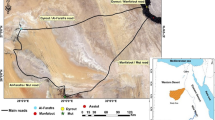Abstract
The objective is to realize the early warning of disasters caused by mountain mass landslide. The probable causes of mountain mass landslide were predicted and analyzed in prior by constructing the back propagation (BP) neural network algorithm, which included earthquake, rainstorm, human activity, landslide displacement, slope gradient, and soil texture. In terms of the early warning of mountain mass landslide caused by earthquakes, rainstorm, or human activities, the accuracy of BP neural network algorithm was relatively high; especially, given the relevant data such as the free slope gradient, slide surface slope gradient, and soil texture of the mountain mass, the accuracy of BP neural network algorithm in the early warning of mountain mass landslide could reach 94.7%; the proposed algorithm could predict not only the occurrence possibility of mountain mass landslide but also the severity and possible range of mountain mass landslide. In addition, in terms of stability, the standard deviation of the proposed algorithm was 0.0062, which indicated the fairly good stability of the algorithm. The possible mountain mass landslide was predicted based on the comprehensive analysis of probable causes of mountain mass landslide and their proportions of weights by using the BP neural network algorithm; the accuracy and stability of the proposed algorithm were excellent, which also showed that the occurrence of mountain mass landslide was a comprehensive consequence caused by various factors and could never be predicted through singular factor analysis. Thus, the understanding of both BP neural network algorithm and mountain mass landslide was greatly improved.





Similar content being viewed by others
References
Erdelj M, Król M, Natalizio E (2017) Wireless sensor networks and multi-UAV systems for natural disaster management. Comput Netw 124:72–86
Fotovatikhah F, Herrera M, Shamshirband S et al (2018) Survey of computational intelligence as basis to big flood management: challenges, research directions and future work. Engineering Applications of Computational Fluid Mechanics 12(1):411–437
Gian QA, Tran DT, Nguyen DC et al (2017) Design and implementation of site-specific rainfall-induced landslide early warning and monitoring system: a case study at Nam Dan landslide (Vietnam). Geomatics, Natural Hazards and Risk 8(2):1978–1996
Goswami S, Chakraborty S, Ghosh S et al (2018) A review on application of data mining techniques to combat natural disasters. Ain Shams Eng J 9(3):365–378
Jung H, Yoo H, Chung K (2016) Associative context mining for ontology-driven hidden knowledge discovery. Clust Comput 19(4):2261–2271
Liu Y, Wu L (2016) Geological disaster recognition on optical remote sensing images using deep learning. Procedia Computer Science 91:566–575
Ma J, Tang H, Liu X et al (2017) Establishment of a deformation forecasting model for a step-like landslide based on decision tree C5. 0 and two-step cluster algorithms: a case study in the Three Gorges Reservoir area, China. Landslides 14(3):1275–1281
Mangla A, Bindal AK, Prasad D (2016) Disaster management in wireless sensor networks: a survey report. Int J Comput Corporate Res 6(3):186–197
Ray PP, Mukherjee M, Shu L (2017) Internet of things for disaster management: state-of-the-art and prospects. IEEE Access 5:18818–18835
Supriyadi B, Windarto AP, Soemartono T (2018) Classification of natural disaster prone areas in Indonesia using K-means. International Journal of Grid and Distributed Computing 11(8):87–98
ur Rahman M, Rahman S, Mansoor S et al (2016) Implementation of ICT and wireless sensor networks for earthquake alert and disaster management in earthquake prone areas. Proc Comput Sci 85:92–99
Wu X, Zhan FB, Zhang K et al (2016) Application of a two-step cluster analysis and the a priori algorithm to classify the deformation states of two typical colluvial landslides in the Three Gorges, China. Environ Earth Sci 75(2):146
Zhou L, Wu X, Xu Z et al (2018a) Emergency decision making for natural disasters: an overview. International journal of disaster risk reduction 27:567–576
Zhou C, Yin K, Cao Y et al (2018b) A novel method for landslide displacement prediction by integrating advanced computational intelligence algorithms. Scientific reports 8(1):7287
Funding
This work was supported by the National Social Science Foundation’s Major Bidding Project in 2018 (18ZDA027) (History, Current Situation and Future of Information Philosophy).
Author information
Authors and Affiliations
Corresponding author
Additional information
This article is part of the Topical Collection on Geological Modeling and Geospatial Data Analysis
Rights and permissions
About this article
Cite this article
Yan, Y., Ashraf, M.A. The application of the intelligent algorithm in the prevention and early warning of mountain mass landslide disaster. Arab J Geosci 13, 79 (2020). https://doi.org/10.1007/s12517-020-5116-3
Received:
Accepted:
Published:
DOI: https://doi.org/10.1007/s12517-020-5116-3




